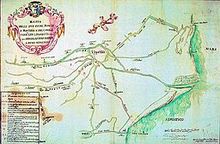Bernardino Zendrini

Bernardino Zendrini (born April 7, 1679 in Saviore dell'Adamello , † May 18, 1747 in Venice ) was an Italian hydraulic engineer , doctor , astronomer and mathematician who was in the service of the Republic of Venice .
Life
Zendrini attended the Jesuit college in Venice, studied philosophy and medicine in Padua with the Laurea degree in 1701 and then was a doctor in his hometown for a while. In 1704 he went to Venice, where he dealt with, among other things, physics (gravity, astronomy, geodesy, hydraulics, electricity, etc.) and worked in the scientific and intellectual circles. Zendrini dealt early in Italy with infinitesimal calculus in the sense of Gottfried Wilhelm Leibniz (as well as with analytical geometry according to René Descartes ). In 1717 he took a position on a disputed problem between Bologna and Ferrara regarding the regulation of the Reno in the spirit of Ferrara and in 1720 became the chief hydraulic engineer for the city of Venice. He advised the Republic of Lucca on the swampy surroundings of Viareggio , which, thanks to the work that lasted from 1741 to around 1750 , was able to push back the rampant malaria , and the Pope in Ravenna on its hydraulic engineering problems (diversion of the rivers Ronco and Montone and construction of a new port) For which he published a proposal in 1731 with Eustachio Manfredi . He also traveled to Vienna, for example, as a consulting engineer. He is buried in the Jesuit Church in Venice. The republic commissioned a portrait bust that is now in the Panteon Veneto.
From around 1738 onwards, Zendrini led the renovation of the dams and stone walls that protected the Venice lagoon from storm surges. To this end, he led the construction of dams made of Istrian karst marble blocks, which were connected with pozzolana cement ( Murazzi ), ran between the island of Pellestrina and the port of Chioggia , the construction of which lasted from 1744 to 1782 and which was originally designed by Vincenzo Maria Coronelli were proposed. The use of pozzolana as cement was already known to the Romans, but was then forgotten until it was rediscovered by Zendrini. In 1747 he published a textbook on hydraulics and hydraulic engineering that used the methods of calculus.
Fonts
- Alcune considerazioni sopra la scienza delle acque correnti, e sopra la storia naturale del Pò per servire di lume nella controversia, che verte frà le città di Ferrara, e di Bologna, 1717
- Giustificazione de fatti prodotti nell'Articolo 2. delle ragioni per escludere il progetto di unire Reno al Po 'di Lombardia, Ferrara 1717
- Relazione che concerne il Miglioramento dell'Aria e la riforma di quel Porto, 1735 (report for the city of Viareggio)
- Leggi e fenomeni, regolazioni e usi delle acque correnti, Venice 1741
literature
- Angelo Zendrini: Elogio di Bernardino Zendrini, Venice 1807
- Luigi Pepe: Il Calcolo infinitesimale in Italia agli inizi del secolo XVIII. Bollettino di Storia delle Scienze Matematiche, 1, 1981, No. 2, pp. 43-101.
- Bernardino Zendrini (1679–1747), matematico e ispettore alle acque della Serenissima, Breno, Quaderni della Fondazione Camunitas, 2010.
Web links
- Zendrini, Bernardino. In: Enciclopedie on line. Istituto della Enciclopedia Italiana, Rome. Retrieved June 22, 2015.
- Biography at the Museo Galileo
- Biography of Lucio Serino 2008, Italian, pdf
- Biography of Luigi Pepe at Matematica italiana, Italian
Individual evidence
- ↑ Paolo Fornaciari: Zendrini e la bonifica di Viareggio Così la città sconfisse la malaria, Il Tirreno, May 30, 2015
| personal data | |
|---|---|
| SURNAME | Zendrini, Bernardino |
| BRIEF DESCRIPTION | Italian engineer and mathematician |
| DATE OF BIRTH | April 7, 1679 |
| PLACE OF BIRTH | Saviore dell'Adamello |
| DATE OF DEATH | May 18, 1747 |
| Place of death | Venice |


